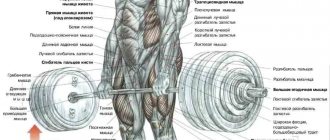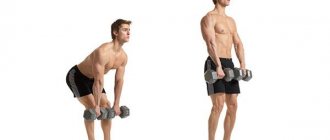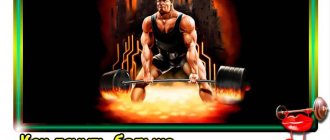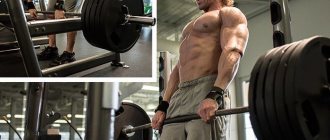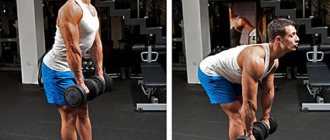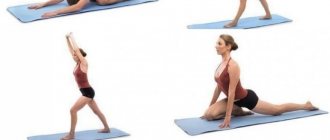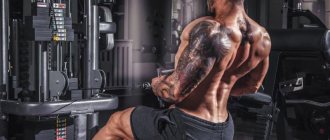Benefits for men and women
Why is deadlifting for everyone? Yes, because this is an indispensable exercise for all muscles of the body . The deadlift is one of the most powerful and large-scale exercises in terms of muscles involved. There is only one “but” - in order to get the maximum benefit from this exercise specifically for strength stimulation, the weights must be quite serious for you.
The classic bent-legged deadlift can be performed in different styles - the style determines the position of the pelvis and hips (high or low) in the starting position, and accordingly, the load can increase or decrease on the spinal extensor muscles (especially the lumbar part) and muscles anterior thigh (quadriceps).
Characteristic of any style of deadlift on bent legs (as opposed to deadlift on straight legs) is the initial effort to lift the barbell off the floor due to extension of the legs at the knee and hip joints and subsequent extension of the torso.
The largest release of anabolic hormones is provoked by the classic heaviest exercises - squats and deadlifts, and if you do not do exercises on the upper body, then all their anabolic effect will affect mainly the muscles of the lower body, i.e. muscles subjected to stress.
However, if in addition to squats and deadlifts, you do rows and presses for the upper body, then muscle growth will occur throughout the body. Hence the well-known expression: “to pump up your arms, you must first pump up your legs.”
Alternative Deadlift Exercises
What can replace deadlifts? I’ll say right away that the following information is intended for those athletes who cannot perform deadlifts due to medical contraindications, but want to work target muscle groups using other exercises.
For everyone else, the answer is: NOTHING.
The deadlift is a multi-joint exercise that uses almost all the muscles in our body. And the effect it has on our strength and muscle mass can hardly be replaced by hyperextensions, barbell bends, or exercises for the hip adductors. Therefore, if you cannot perform deadlifts because axial load on the spine is contraindicated for you, include the following exercises in your training process:
- Pull-ups on the bar – probably the best exercise in the world for gaining back muscle mass and creating a V-shaped silhouette. It is important to try to carry out the movement by contracting the latissimus muscles, bringing and spreading the shoulder blades, while minimally including the forearms and biceps. This way you will get maximum efficiency from this exercise. Perform other lat exercises where the axial load is minimal (wide-grip vertical pull-down, close-grip horizontal pull-down, overhead pullover, hummer row, etc.) in order to put more stress on the muscles and create the preconditions for growth of muscle mass.
© Makatserchyk — stock.adobe.com
- Hyperextension – an exercise that perfectly develops the main muscle group that works during the classic deadlift – the spinal extensors. It is noteworthy in that the axial load in it is practically zero, therefore it is strongly recommended to be performed not only as an alternative to the deadlift, but also as an addition to it, and as a general strengthening preventive exercise, and as an exercise aimed at rehabilitating an injured lower back.
© Makatserchyk — stock.adobe.com
- Reverse hyperextensions – a type of hyperextension where the athlete contracts the target muscle group by lifting the legs rather than the body. The load here is more directed at the lower part of the spinal extensors; the sacrum area receives the maximum blood flow.
- Advances and flyes while sitting in the simulator – exercises with which you can separately load the adductor muscles of the thigh and buttocks without axial load on the spine. Therefore, if the sumo deadlift is contraindicated for you, you may well include these two exercises in your arsenal.
© Makatserchyk — stock.adobe.com
What muscles work
So, let's find out which muscles are involved when performing it:
- At the beginning of the movement, the gluteal muscles are included in the activity.
- Straightening your body and bending your knees strains your quadriceps and hamstrings.
- The hamstrings are activated when bending and holding weight.
- The back muscles are constantly tense. They are adjacent to the trapezius and rhomboid muscles, as well as the muscles in the area of flexion of the spinal column - they fix the spine in a neutral position, acting as stabilizers.
- When extending the pelvis, the muscles of the posterior thigh are involved - the semitendinosus, semimembranosus, biceps femoris and gluteal region.
- The muscles of the anterior thighs are activated during leg extension and hip flexion.
What the deadlift does depending on its type and apparatus:
- The classic one with a barbell or dumbbells involves more of the large muscles of the back and legs .
- What muscles work when sumo deadlifting? With sumo , the back is also loaded, but less, but the inner thighs and biceps .
- In the Romanian or straight leg deadlift for girls (as it is commonly called), the back of the thighs , while the load on the back muscles is reduced.
- Pulls from a pit or from a hill the gluteal muscles the most .
Types of grip
The most convenient grip for performing this exercise is “mixed” (“mixed grip”). When using it, the thumbs are pointed in one direction. This grip prevents the apparatus from slipping out of your hands, but it helps create a torque on the spinal column, so it is most often used by professional athletes trying to lift maximum weight.
Among beginners and amateurs, the most popular is the “direct grip”, which provides maximum load on the athlete’s forearms.
Technique by type
Let's start analyzing the execution technique with the classics with a barbell:
Classic with barbell
The technique, of course, will be the same for men and women, but it is this classic option that is traditionally chosen by boys, because They care more about the overall development of muscles and strength, rather than targeting specific muscles.
How to do deadlifts with a barbell:
- Come close to the bar, place your feet narrower than your shoulders and parallel to each other (or place your feet wider than your shoulders - you will get a sumo deadlift with more load on the glutes).
- Squat down and grab the barbell with an overhand grip, the distance is slightly wider than shoulder width. The arms are vertical, the shoulders are under the barbell, the gaze is directed straight ahead.
- Take a deep breath and, as you exhale, begin to lift the barbell. The takeoff is smooth and even (no jerking from the floor), the bar slides along the legs, make sure that the bar moves along a vertical path and passes as close to the shins and hips as possible.
- Keep your back (as in a squat) strictly straight, with a natural arch in the lower back.
- After passing the barbell through your knees, you should straighten up completely, slightly squeeze your shoulder blades together, and proudly push your chest forward. Important point : the barbell does not need to be pulled with your hands; they act as cables.
- We return to the starting position. Lowering the barbell begins with bending your knees, moving your buttocks back and simultaneously lowering your straight back forward. It is very important to ensure that the back does not round , to keep it straight using the abdominal muscles and erector spinae, as well as the flattened shoulder blades.
Beginners need to strengthen their back and leg muscles before starting deadlifts. Do hyperextensions , pull-ups , squats and lunges .
On straight legs
What is the difference between classic deadlift and Romanian deadlift, what are the differences with the so-called. dead? Yes, everything: the stereotype of movement, the effect, even which muscles ultimately swing.
As for the deadlift on straight legs, which, according to the movement stereotype, is a complete analogue of the “good morning” bend over with a barbell on the shoulders or the Romanian deadlift, this version of the deadlift will not be a general strength exercise like the classic or sumo.
The technique of performing Romanian deadlifts on straight legs with a barbell and dumbbells is described in detail in this article .
This is a highly specialized exercise for the back extensors and hamstrings, and secondarily for the glutes. When performing deadlifts on straight legs, the impact on the spinal extensor muscles becomes dangerous, so deadlifts on straight legs should be performed extremely carefully and only under the supervision of a trainer .
And remember that “straight legs” is a relative definition, the knees should ALWAYS be slightly bent, and the barbell weights should be light.
With dumbbells
How to perform this variation correctly? There are no fundamental and important differences in the technique of performing deadlifts with dumbbells - the stereotype of movement is still the same, attention needs to be paid to the same points, so there is no point in retelling it.
We are often asked, what is better, a barbell or a dumbbell? What would be more effective to perform deadlifts with in this case? Well, that's an interesting question. Let's think about it:
- The most obvious difference: limited weight . The barbell is more variable in terms of increasing working weight.
- Asymmetrical load . Most barbell movements are performed symmetrically in the lateral plane. These include deadlifts, squats, and bench presses - in them both arms/legs must perform the same actions. The barbell forces the body to “tighten” its weak points so that there are no various distortions and displacements during movements.
- On the other hand, dumbbells may provide better balance , especially if you have problems with coordination or strength development in your arms/legs. Lifting two loads simultaneously and synchronously will help distribute the load more safely.
- In addition, dumbbells give him more wide range of motion, this is especially important for those whose technique cannot be canonical due to some characteristics - too long arms / short torso / unstretched muscles, etc.
The barbell in such a situation will be much more uncomfortable and traumatic. Dumbbells can comfortably place the weight around your body and work in a more anatomically convenient range of motion for you.
- Movements with dumbbells are more natural for the body from a biomechanical point of view, so the dumbbell version should be the starting option for beginners - technically it is easier, since the dumbbells can be placed on the sides of the body, thus bringing their center of gravity closer to the center of gravity of your body.
In general, of course, the classic deadlift is a deadlift with a barbell. Dumbbells cannot provide the required working weight, plus most people, instead of deadlifting with dumbbells, end up with something between a Romanian and squats.
Holding dumbbells the same way as a barbell so that the load is applied to the same muscles is difficult and uncomfortable, therefore, when performing deadlifts with dumbbells, you do not need to use a huge working weight, it is better to work in a high repetition range (12 and above), concentrate on stretching and contraction of the working muscles and adhere to the filigree technique of performing the exercise.
For this reason, deadlifts with dumbbells are perfect for girls and less so for men (although someone knows that) - it is effective, and the risk of injury when performing it is minimal.
And more classically, strength training enthusiasts do this: deadlifts are done with a barbell/bar, and Romanian (deadlifts) are done with dumbbells for better isolation.
On one leg
Read all about this type of deadlift The secret and very effective exercise for the buttocks: Romanian single leg deadlift
With a weight
Let's say together - you don't need it. We don’t like this type of deadlift - the center of gravity shifts and you get a certain echo of a squat, this is not a canonical, correct execution. In this position, more stress will be placed on the legs rather than on the back.
You can, if you choose, do kettlebell deadlifts with a wide stance, two kettlebells at once, or a kettlebell in one hand. But of course, the option with a barbell loads the muscles much more effectively.
For girls
If you are looking for an option that will load the buttocks and the back of the thigh more strongly and better, then a) always lower the barbell/dumbbells to the floor and get up from the squat, don’t try, b) add the Romanian deadlift to your training, c) try the deadlift from the pit.
Out of the pit
Important: this is the most difficult type of deadlift, both in technique and execution, and it is very easy to get injured. Suitable only for experienced ones, with good stretching, without problems with knees, hip joints or back.
The pit row is generally performed in the same way as the classic version, but the person stands on a stand/elevation of 5-10 cm, this can be (and most often) a CrossFit disc. Thus, the barbell must be pulled and lowered to a lower position. The amplitude increases - the efficiency increases.
You must lower your pelvis low, so that your knees are completely bent - this is unrealistically difficult, we’ll say it right away and blab it out again - it’s dangerous, so it’s better not to joke with this exercise.
The technique in the pit deadlift is fundamentally the same as in the classic exercise. However, if you do not have the proper stretch, you will have a very difficult time lowering and lifting the barbell, especially with weight, since you still have to reach it. Also, you can’t get too high, otherwise you will definitely stretch, and God forbid, injure the muscles to the point of rupture.
With elastic band
There are several options for using an elastic band (tape expander). You can either perform deadlifts only with it, or use it as additional equipment to the existing weight in the form of a barbell or dumbbell:
There is another interesting way to use bands (in the video) - this is an excellent option for those who need to work on the final phase of the movement, when the weight is maximum and the barbell is at the top, and also practice breaking the barbell off the platform.
What are the advantages of working with rubber bands:
- Single band deadlifts allow you to place the weight on the sides of your body, which is more comfortable for people with joint and back problems.
- The more you bend your legs, the more your glutes will work. The less, the more actively the back surface of the thigh will be involved in the work.
- In order to better feel the buttocks, it is better to combine it with leg raises in the simulator or gluteal swings .
What does science say? The most informative is a meta-analysis of resistance band training research by Chris Beardsley, a scientist and managing director of Strength and Conditioning Research. After analyzing a huge amount of data, the scientist came to the following conclusions:
- Elastic resistance can result in comparable or even greater levels of muscle activity during an exercise compared to similar free weight exercises with the same relative or absolute loads.
- If the goal is maximum hypertrophy, you should use both expanders and free weights in your exercises, because these exercises are different in nature and involve muscles in different ways.
- Exercises with resistance bands involve less joint force than similar exercises with free weights - this reduces the risk of injury.
- It makes sense to perform exercises not for the number of repetitions, but for a time - start with 30 seconds.
- Combine exercises with free weights and resistance bands rather than focusing on just one thing.
In Smith
In general, there are no differences in technology from the classics. In fact, performing a deadlift in Smith is an easier and much less traumatic and gentle option compared to free weights. But, at the same time, it must be admitted that it is less effective for developing strength and mass compared to a barbell.
Pros and cons of Smith machine deadlifts:
- The Smith machine sets the correct trajectory and guides you, so you don't have to worry about losing balance and coordination.
- The risk of injury in the Smith machine is less than in the classic version of the exercise. Therefore, it is especially recommended for people with existing injuries and problematic joints.
- The weight in the machine moves strictly in a vertical trajectory, which prevents displacement in any direction, which means that this type of deadlift is preferable for people with back and spine problems.
- In addition, at any moment you can stop and fix the bar at some point (or even throw it, it still won’t hit your legs) if you feel that something has gone wrong.
- Of the minuses: the stabilizer muscles (especially the core muscles) are not activated; in general, it is much easier to do than with free weights, so the working weight will have to be taken more so that the load is the same.
Advice: it becomes more convenient from the side of the simulator, and not in front of it, in order to rotate it away from you when lifting the bar from the clamps.
Deadlift Standards
Separate deadlift competitions are held under the auspices of all powerlifting federations operating in Russia (FPR, WPC/AWPC, ASM “Vityaz”, etc.). At the same time, there is no distinction as to what style the athlete should pull in: sumo or classic. For many athletes, this moment causes indignation, some demand the introduction of a separate division for sumo deadlifting, some demand that sumo deadlifting be completely banned, and existing records invalidated, or the creation of a separate federation where everyone will lift in sumo... These statements are heard, in my opinion, it is simply absurd. The rules of the federation do not regulate any type of deadlift as the only correct one, and each athlete has the right to choose the style in which he is able to show the greatest results, at his own discretion.
Below are the standards for deadlifts for men, approved by probably the most popular federation among amateur athletes - AWPC (doping control division). The standards of this federation for deadlift are quite democratic, so it will not be too difficult for any more or less prepared athlete to prepare for some regional competitions and first complete the first adult category. And then - more. Therefore, if you have already achieved certain results in the deadlift, try to confirm them in competitions. An adrenaline rush and an unforgettable experience are guaranteed.
Rating standards for men's deadlift without equipment (AWPC):
| Weight category | Elite | MSMK | MS | KMS | I category | II category | III category | I junior | II junior |
| 52 | 197,5 | 175 | 152,5 | 132,5 | 115 | 105 | 90 | 75 | 60 |
| 56 | 212,5 | 187,5 | 162,5 | 142,5 | 125 | 115 | 97,5 | 82,5 | 65 |
| 60 | 225 | 200 | 172,5 | 150 | 132,5 | 120 | 105 | 87,5 | 70 |
| 67,5 | 247,5 | 217,5 | 190 | 165 | 145 | 132,5 | 112,5 | 95 | 75 |
| 75 | 265 | 232,5 | 202,5 | 177,5 | 155 | 142,5 | 122,5 | 102,5 | 80 |
| 82,5 | 277,5 | 245 | 215 | 185 | 162,5 | 150 | 127,5 | 107,5 | 85 |
| 90 | 290 | 255 | 222,5 | 195 | 170 | 155 | 132,5 | 112,5 | 90 |
| 100 | 302,5 | 267,5 | 232,5 | 202,5 | 177,5 | 162,5 | 140 | 115 | 92,5 |
| 110 | 312,5 | 275 | 240 | 207,5 | 182,5 | 167,5 | 145 | 120 | 95 |
| 125 | 322,5 | 285 | 247,5 | 215 | 190 | 175 | 150 | 125 | 100 |
| 140 | 332,5 | 292,5 | 255 | 222,5 | 192,5 | 177,2 | 152,5 | 127,5 | 102,5 |
| 140+ | 337,5 | 300 | 260 | 225 | 197,5 | 182,2 | 155 | 130 | 105 |
You can download and print the table if necessary using the link.
For women:
| Weight category | Elite | MSMK | MS | KMS | I category | II category | III category | I junior | II junior |
| 44 | 127,5 | 115 | 100 | 85 | 75 | 70 | 60 | 50 | 40 |
| 48 | 140 | 122,5 | 107,5 | 92,5 | 82,5 | 75 | 65 | 52,5 | 42,5 |
| 52 | 150 | 132,5 | 115 | 100 | 87,5 | 80 | 70 | 57,5 | 45 |
| 56 | 157,5 | 140 | 122,5 | 105 | 92,5 | 85 | 72,5 | 60 | 47,5 |
| 60 | 165 | 147,5 | 127,5 | 110 | 97,5 | 90 | 77,5 | 62,5 | 50 |
| 67,5 | 177,5 | 157,5 | 135 | 117,5 | 102,5 | 95 | 82,5 | 67,5 | 55 |
| 75 | 185 | 165 | 142,5 | 125 | 110 | 100 | 85 | 72,5 | 57,5 |
| 82,5 | 192,5 | 170 | 150 | 130 | 112,5 | 105 | 90 | 75 | 60 |
| 90 | 200 | 177,5 | 152,5 | 132,5 | 117,5 | 107,5 | 92,5 | 77,5 | 62,5 |
| 90+ | 202,5 | 180 | 155 | 135 | 120 | 110 | 95 | 80 | 65 |
You can download and print the table if necessary using the link.
Important points
- You need to lower and raise the barbell quite slowly and smoothly;
- The downward movement must begin by moving the pelvis back;
- The bar should slide along your thighs throughout the entire movement;
- The lower back should be arched;
- After passing your knees (downward movement), you need to touch the floor bar with the weights;
- Mentally imagine that instead of lifting up, you press your feet into the floor;
- Both during lifting and while lowering the barbell, you should not put your body weight on your toes . In this case, the bar will move forward from your legs and you can simply fall forward.
- Don't do deadlifts off the floor, i.e. don't throw her away. Even if you feel like you can't lift the barbell - under no circumstances leave her. Lower it, if possible, smoothly, so that the load from your back is removed not suddenly, but gradually. Sudden removal of the load can seriously injure the muscles of the back, elbows or shoulders.
By working back and forth, you make your work much easier and pass the critical point of removing the barbell at speed. The meaning of such training disappears. Additionally, “pounding” can cause the plates on one side of the bar to slide down the bar.
This will lead to loss of control of the barbell, asymmetrical lifting of the weight and uneven load on the body, which can lead to serious spinal injuries.
- Never twist your head when you lower or raise the barbell - the barbell may tilt slightly to the side, you will be pulled to the side, and you may injure yourself.
- Don't deadlift reps to failure, don't do forced or negative reps. In such a serious exercise as the deadlift, these experiments are not appropriate.
- Do not perform deadlifts if your lower back muscles are still quite sore from your last workout or even from regular heavy physical labor. Rest for a day or two and wait until the muscle pain goes away.
- Breathing: inhale – slowly down, exhale – up.
- Avoid the main mistake of rounding your back; to do this, try to look up.
Error in all its glory
